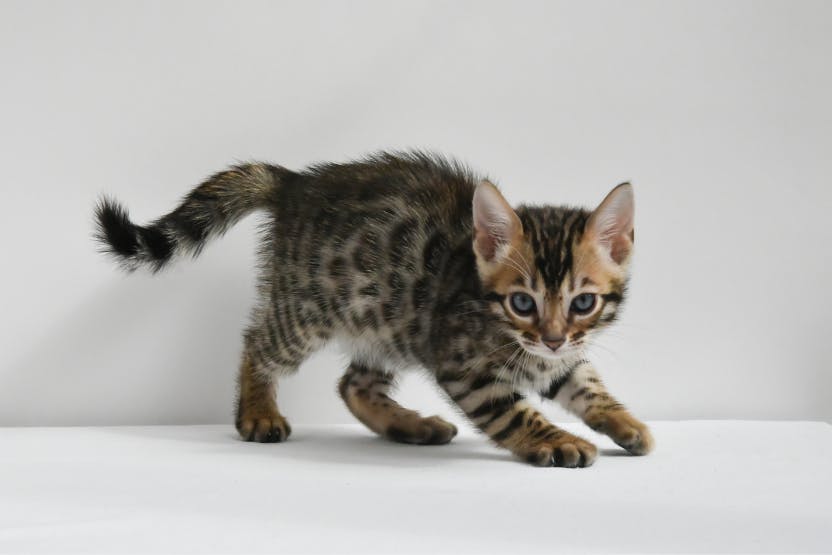- Home
- Dog Wellness
- 5 Common Behavioral Problems in Kittens

By Emily Bayne
Published: 02/02/2022, edited: 02/02/2022
Save on pet insurance for your pet
You don't have to choose between your pet and your wallet when it comes to expensive vet visits. Prepare ahead of time for unexpected vet bills by finding the pawfect pet insurance.
- House soiling
- Common causes of house soiling
- Tips for preventing house soiling
- Aggression
- Common causes of feline aggression
- Tips for managing aggression in cats
- Clawing furniture
- Common causes of clawing furniture
- Tips for preventing your cat from clawing furniture
- Excessive vocalizations
- Common causes of excessive vocalization
- Tips for preventing excessive vocalizations
- Destructive chewing
- Common causes of destructive chewing
- Tips for preventing destructive chewing
- Stress. Psychological stress like losing a loved one, being rehomed, or experiencing a traumatic event can cause cats to seemingly "forget" their litter box training.
- Medical problems. Health conditions that cause lack of bladder control, increased urination, or urgency can also cause cats to refuse the litter box.
- Environmental changes. Moving or rearranging your home can cause confusion and stress, leading to house soiling.
- Dirty litter boxes. Going too long between litter box cleanings can cause cats to find a new place to potty. Cats are meticulous about cleanliness, so the idea of stepping into a dirty litter pan can cause cats to want to go elsewhere.
- Fear. Some cats exhibit housetraining regression due to fear of the litter box, particularly if the box is new. Covered boxes or boxes with automatic scooping features are especially intimidating to young cats.
- Relocate the litter box. Place the litter box where your cat has the most accidents. If your cat is obsessed with going potty in the bathroom closet, put the box there until they get the hang of using it.
- Use positive reinforcement when your cat uses their litter box. Place your cat in the litter pan periodically throughout the day and reward them when they use it. You may reward them with high-value treats, catnip, or fun toys they only get to play with after going potty.
- Scoop the litter frequently. Many pet parents are surprised that scooping the litter more often is the key to preventing accidents. Cats are notorious clean freaks and don't like to get their paws dirty. Scoop the box at least once daily, or 3 times a day if you have multiple cats.
- Change litter pan and substrate. If your cat refuses to go near the litter box, try changing their setup. Opt for unscented litter and an open-air style pan instead of a covered one (or vice versa) until you find a combo that your cat likes.
- Play aggression. Play aggression, also called predatory aggression, is when a cat exhibits predatory behaviors like pouncing, biting, or clawing during playtime.
- Inter-cat aggression. Inter-cat aggression is when a cat becomes aggressive with other members of their species.
- Food aggression. Food aggression is when a cat attacks others or exhibits aggressive body language while guarding their food.
- Overstimulation. This type of aggression is due to overhandling and excessive petting.
- Fear aggression. Fear aggression is aggressive behavior that arises when a cat feels afraid or intimidated.
- Territorial aggression. Territorial aggression is most common in males and occurs when a feline becomes violent and protective over a specific area of the home.
- Behavior modification and counterconditioning techniques. These techniques can encourage appropriate responses to stimuli that would normally trigger aggression.
- Make a loud noise. If your cat is acting aggressively, try clapping your hands to break their concentration.
- Avoid doing things that trigger your cat's aggression. If you know something triggers your cat's aggression (like petting their stomach), avoid doing these things when possible.
- Do not use aversive methods of punishment. Spanking and yelling can worsen pet aggression.
- Seek professional help. If your cat regularly displays aggressive tendencies, seek advice from a veterinarian or a professional animal behaviorist.
- Repellent sprays. Repellant sprays may discourage cats from scratching certain areas of your home. These sprays have an unpleasant odor and may stain fabric surfaces, so use them with caution.
- Nail caps. Nail caps are silicone or plastic covers that slide over a cat's nails and minimize damage caused by furniture scratching.
- Scratching post. Invest in a scratching post and cover it in catnip or pheromone sprays to encourage your kitten to use that instead of your couch. If that doesn't work, try one of these training methods.
- Hunger
- Attention-seeking
- Confusion
- Greeting their parents or other pets
- Being in heat
- Pain or certain medical conditions
- Aggression or territorial behavior (depending on the type of vocalization)
- Genetics
- Break your cat's daily food allotment into separate smaller meals, and feed them throughout the day
- Don't respond to excessive vocalizations since this may reinforce the behavior.
- Take your cat to the vet to rule out contributing health conditions.
- Take time to play with and pet your kitten throughout the day.
- Try these training techniques to discourage yowling.
- Store dangerous items like cleaning chemicals up high, and use wire covers and cable management methods to prevent wire chewing.
- If your cat is a boredom chewer, you may want to offer mental stimulation through one of these fun boredom-busting activities.
- Catnip toys may provide a positive outlet for predatory instincts and prevent destructive chewing.
- Repellent sprays may help discourage your cat from chewing specific items.
- If your cat’s destructive chewing persists, you may want to have your vet document the behavior and refer you to a behaviorist. Vets can also offer guidance on ways to prevent chewing and chewing-related injuries.

